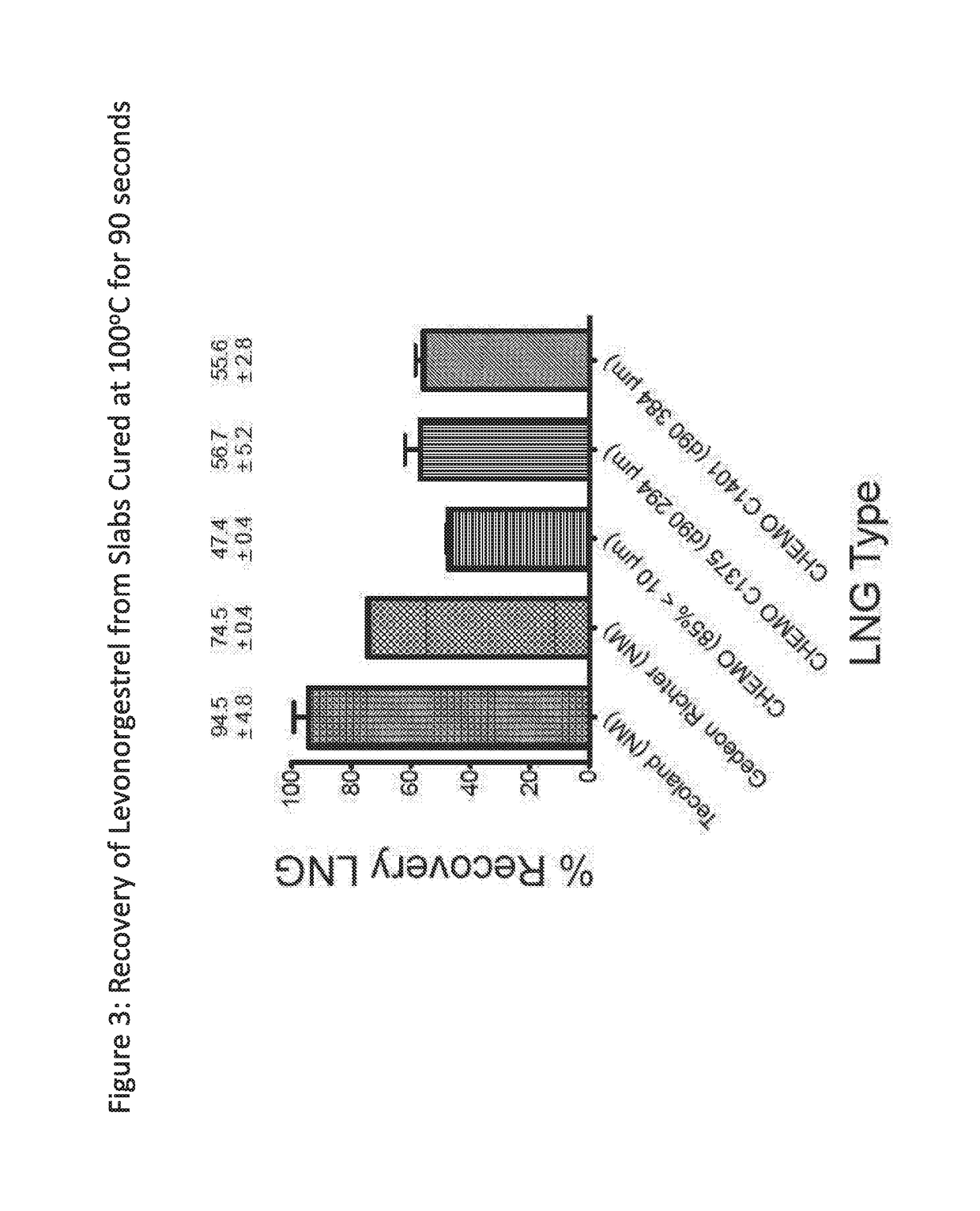Platinum-catalyzed silicone drug delivery devices and methods of use thereof
a technology of silicone and drug delivery, which is applied in the direction of tampons, organic active ingredients, inorganic non-active ingredients, etc., can solve the problems that the chemical binding of such apis with silicone elastomer materials has not been previously reported, and achieves reduced drug solubilization, reduced binding of suitably-functionalized, and increased recovery
- Summary
- Abstract
- Description
- Claims
- Application Information
AI Technical Summary
Benefits of technology
Problems solved by technology
Method used
Image
Examples
example 1
of Binding of Contraceptive to Silicone
[0207]Formulations of dapivirine (DAP or DPV) with a contraceptive hormone were investigated for use with a multipurpose prevention technology (MPT) intravaginal ring system. Dapivirine and non-micronized levonorgestrel (LNG), micronized ethinyl estradiol (EE), or micronized etonogestrel (ET) were studied in condensation cured (Sn) or addition cured (Pt) silicone systems.
[0208]Matrix-type vaginal rings were manufactured by injection moulding, using either MEDS-6382 (condensation-cured) or LSR9-9508-30 (addition-cured) silicone elastomers. Release of DAP and LNG from the LSR9-9508-30 rings was diffusion-controlled for the duration of the 21-day study. Total DAP release was 41% of the initial loading, while only 29% LNG loading was released. Both drugs would have continued to be released beyond 21 days had the study had continued. However, release of EE and ET ceased after 13 and 8 days respectively, with only 36 and 23% of initial drug loading r...
example 2
f Micronized Versus Non-Micronized Levonorgestrel
[0210]Platinum-catalyzed silicone matrix intravaginal rings comprising 200 mg micronized dapivirine and 32 mg levonorgestrel (both micronized and non-micronized) were utilized in this study. FIGS. 1 and 2 depict the mean and cumulative daily release of dapivirine and levonorgestrel versus time for micronized levonorgestrel and micronized dapivirine on storage stability.
[0211]Due to the negligible release of levonorgestrel detected initially (T0), two of the rings that had been tested were immediately assayed for residual content along with two equivalent rings from the non-micronized levonorgestrel arm of the study. The residual content assay results showed almost no recovery of levonorgestrel from rings containing micronized levonorgestrel and a reduced recovery from those rings containing non-micronized levonorgestrel. Data collected from the week-two time point (see FIGS. 1 and 2) showed a similar lack of levonorgestrel release des...
example 3
[0214]Surprisingly, non-micronized levonorgestrel, with larger particle size, appeared to have increased release from the platinum catalyzed silicone rings as compared to the micronized levonorgestrel material, with smaller particle size. Since there seemed to be a difference in release profile from dapivirine / levonorgestrel rings made with non-micronized versus micronized levonorgestrel, formulations were made with levonorgestrel with different particle size distribution (PSD) and from different suppliers.
[0215]FIG. 3 depicts the recovery of levonorgestrel from formulations made with different batches of levonorgestrel. At the processing conditions shown, recovery non-micronized levonorgestrel supplied by Chemo was significantly lower than recovery of non-micronized LNG supplied by Tecoland.
[0216]Two additional Chemo LNG batches (Materials 5 and 6, C1375 and C1401) described as having large particle size (d90 values of 294 μm and 384 μm, respectively) were ...
PUM
| Property | Measurement | Unit |
|---|---|---|
| particle size | aaaaa | aaaaa |
| temperature | aaaaa | aaaaa |
| temperature | aaaaa | aaaaa |
Abstract
Description
Claims
Application Information
 Login to View More
Login to View More - R&D
- Intellectual Property
- Life Sciences
- Materials
- Tech Scout
- Unparalleled Data Quality
- Higher Quality Content
- 60% Fewer Hallucinations
Browse by: Latest US Patents, China's latest patents, Technical Efficacy Thesaurus, Application Domain, Technology Topic, Popular Technical Reports.
© 2025 PatSnap. All rights reserved.Legal|Privacy policy|Modern Slavery Act Transparency Statement|Sitemap|About US| Contact US: help@patsnap.com



